
NGC 485, also commonly referred to as PGC 4921 or GC 270, is a spiral galaxy in the constellation Pisces. It is located approximately 86 million light-years from Earth and was discovered on January 8, 1828 by astronomer William Herschel. It was later also observed by Heinrich d'Arrest and Herman Schultz. When NGC 485 was originally categorized in the New General Catalogue by John Louis Eil Dreyer in 1888, it was incorrectly described as a "considerably faint, pretty large, round, 8th magnitude star 3 1/2 arcmin to southwest".

NGC 690 is an intermediate spiral galaxy located in the constellation Cetus about 236 million light-years from the Milky Way. It was discovered by the American astronomer Francis Leavenworth in 1885.
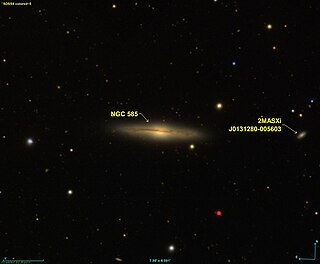
NGC 585 is a spiral galaxy in the constellation of Cetus, which is about 245 million light-years from the Milky Way's center. The object was discovered on December 20, 1827 by the British astronomer John Frederick William Herschel.

NGC 630 is an elliptical galaxy in the constellation Sculptor. It is estimated to be 275 million light years from the Milky Way and has a diameter of approximately 125,000 light years. The object was discovered on October 23, 1835 by the English astronomer John Herschel.

NGC 701 is a spiral galaxy with a high star formation rate in the constellation Cetus. It is estimated to be 86 million light years from the Milky Way and has a diameter of approximately 65,000 light years. The object was discovered on January 10, 1785 by the German-British astronomer William Herschel.
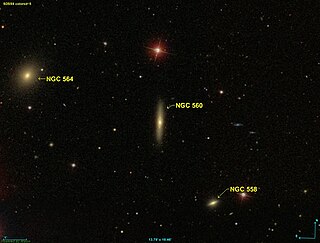
NGC 560 is a lenticular galaxy in the constellation Cetus. It is estimated to be about 250 million light-years from the Milky Way and has a diameter of approximately 150,000 light years. It is part of the Abell 194 galaxy cluster. NGC 560 was discovered on October 1, 1785 by the German-British astronomer William Herschel.
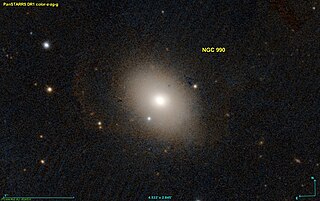
NGC 990 is an elliptical galaxy located in the constellation Aries about 153 million light-years from the Milky Way. It was discovered by the German - British astronomer William Herschel in 1786.

NGC 670 is a lenticular galaxy located in the Triangulum constellation about 165 million light years from the Milky Way. It was discovered by the German-British astronomer William Herschel in 1786.

NGC 790 is a lenticular galaxy in the constellation Cetus. It is estimated to be 233 million light-years from the Milky Way and has a diameter of approximately 90,000 light years. NGC 790 was discovered on September 10, 1785 by the German-British astronomer William Herschel.

NGC 550 is a spiral galaxy in the constellation Cetus. It is estimated to be about 300 million light-years from the Milky Way and has a diameter of approximately 110,000 light years. The German-British astronomer William Herschel discovered it on 8 October 1785.

NGC 904 is an elliptical galaxy in the constellation Aries. It is estimated to be 244 million light years from the Milky Way and has a diameter of approximately 85,000 ly. NGC 904 was discovered on 13 December 1884 by the astronomer Edouard Stephan.
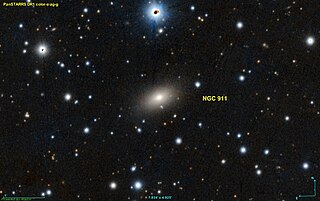
NGC 911 is an elliptical galaxy located in the constellation Andromeda about 258 million light years from the Milky Way. It was discovered by French astronomer Édouard Stephan in 1878. It is a member of the galaxy cluster Abell 347.

NGC 804 is a lenticular galaxy located in the Triangulum constellation about 231 million light-years from the Milky Way. It was discovered by the American astronomer Lewis Swift in 1885. This galaxy was also observed by the French astronomer Guillaume Bigourdan on December 24, 1897, and it has been added to the Index Catalogue under the symbol IC 1773.

NGC 736 is an elliptical galaxy in the constellation Triangulum. It is an estimated 200 million light years from the Milky Way and has a diameter of approximately 85,000 light years. NGC 736 was discovered on September 12, 1784 by the German-British astronomer William Herschel.

NGC 768 is a barred spiral galaxy located in the constellation Cetus about 314 million light years from the Milky Way. It was discovered by the American astronomer Lewis Swift in 1885.

NGC 645 is a barred spiral galaxy in the constellation Pisces. It is estimated to be 112 million light-years from the Milky Way and has a diameter of approximately 115,000 light years. The object was discovered on October 27, 1864 by astronomer Albert Marth.

NGC 624 is a barred spiral galaxy in the constellation of Cetus, which is about 264 million light years from the Milky Way. It was discovered on November 28, 1785, by the German-British astronomer William Herschel.

NGC 656 is a barred lenticular galaxy located in the Pisces constellation about 175 million light-years from the Milky Way. It was discovered by the Prussian astronomer Heinrich d'Arrest in 1865.

NGC 861 is a spiral galaxy in the constellation Triangulum. It is estimated to be 360 million light-years from the Milky Way and has a diameter of approximately 165,000 light-years. The object was discovered on September 18, 1865 by Heinrich d'Arrest.
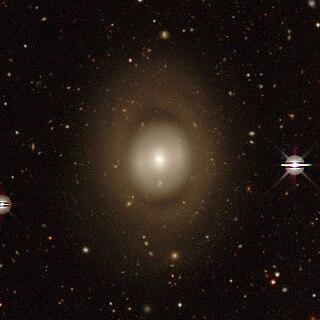
NGC 979 is a lenticular galaxy located within the constellation of Eridanus. This galaxy has a possible outer ring which is dim but smooth. This structure might be a polar ring. The featurelessness of this galaxy means that it is completely devoid of HII regions and consequently, star formation.




















